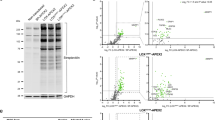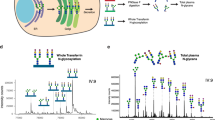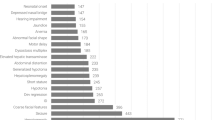Abstract
Mutations involving gains of glycosylation have been considered rare, and the pathogenic role of the new carbohydrate chains has never been formally established. We identified three children with mendelian susceptibility to mycobacterial disease who were homozygous with respect to a missense mutation in IFNGR2 creating a new N-glycosylation site in the IFNγR2 chain. The resulting additional carbohydrate moiety was both necessary and sufficient to abolish the cellular response to IFNγ. We then searched the Human Gene Mutation Database for potential gain-of-N-glycosylation missense mutations; of 10,047 mutations in 577 genes encoding proteins trafficked through the secretory pathway, we identified 142 candidate mutations (∼1.4%) in 77 genes (∼13.3%). Six mutant proteins bore new N-linked carbohydrate moieties. Thus, an unexpectedly high proportion of mutations that cause human genetic disease might lead to the creation of new N-glycosylation sites. Their pathogenic effects may be a direct consequence of the addition of N-linked carbohydrate.
This is a preview of subscription content, access via your institution
Access options
Subscribe to this journal
Receive 12 print issues and online access
$209.00 per year
only $17.42 per issue
Buy this article
- Purchase on Springer Link
- Instant access to full article PDF
Prices may be subject to local taxes which are calculated during checkout







Similar content being viewed by others
References
Casanova, J.L. & Abel, L. Genetic dissection of immunity to mycobacteria: the human model. Annu. Rev. Immunol. 20, 581–620 (2002).
Newport, M.J. et al. A mutation in the interferon-gamma-receptor gene and susceptibility to mycobacterial infection. N. Engl. J. Med. 335, 1941–1949 (1996).
Jouanguy, E. et al. Interferon-gamma-receptor deficiency in an infant with fatal bacille Calmette-Guerin infection. N. Engl. J. Med. 335, 1956–1961 (1996).
Dorman, S.E. & Holland, S.M. Mutation in the signal-transducing chain of the interferon-gamma receptor and susceptibility to mycobacterial infection. J. Clin. Invest. 101, 2364–2369 (1998).
Altare, F. et al. Inherited interleukin 12 deficiency in a child with bacille Calmette-Guérin and Salmonella enteritidis disseminated infection. J. Clin. Invest. 102, 2035–2040 (1998).
Altare, F. et al. Impairment of mycobacterial immunity in human interleukin-12 receptor deficiency. Science 280, 1432–1435 (1998).
de Jong, R. et al. Severe mycobacterial and Salmonella infections in interleukin-12 receptor-deficient patients. Science 280, 1435–1438 (1998).
Dupuis, S. et al. Impairment of mycobacterial but not viral immunity by a germline human STAT1 mutation. Science 293, 300–303 (2001).
Fieschi, C. et al. A novel form of complete IL-12/IL-23 receptor beta1-deficiency with cell surface-expressed non-functional receptors. Blood 104, 2095–2101 (2004).
Casanova, J.L. & Abel, L. The human model: a genetic dissection of immunity to infection in natural conditions. Nat. Rev. Immunol. 4, 56–66 (2004).
Jouanguy, E. et al. In a novel form of complete IFNγR1 deficiency, cell-surface receptors fail to bind IFNγ. J. Clin. Invest. 105, 1429–1436 (2000).
Jouanguy, E. et al. Partial interferon-gamma receptor 1 deficiency in a child with tuberculoid bacillus Calmette-Guerin infection and a sibling with clinical tuberculosis. J. Clin. Invest. 100, 2658–2664 (1997).
Jouanguy, E. et al. A human IFNGR1 small deletion hotspot associated with dominant susceptibility to mycobacterial infection. Nat. Genet. 21, 370–378 (1999).
Döffinger, R. et al. Partial interferon gamma receptor signalling chain deficiency in a patient with bacille Calmette-Guérin and Mycobacterium abscessus infection. J. Infect. Dis. 181, 379–384 (2000).
Dorman, S.E. et al. Clinical features of dominant and recessive interferon gamma receptor 1 deficiencies. Lancet 364, 2113–2121 (2004).
Dupuis, S. et al. Impaired response to interferon-alpha/beta and lethal viral disease in human STAT1 deficiency. Nat. Genet. 33, 388–391 (2003).
Rosenzweig, S.D. et al. A novel mutation in IFN-gamma receptor 2 with dominant negative activity: biological consequences of homozygous and heterozygous states. J. Immunol. 173, 4000–4008 (2004).
Feinbezzzrg, J. et al. Bacillus Calmette Guerin triggers the IL-12/IFN-gamma axis by an IRAK-4- and NEMO-dependent, non-cognate interaction between monocytes, NK, and T lymphocytes. Eur. J. Immunol. 34, 3276–3284 (2004).
Lowe, J.B. & Marth, J.D. A genetic approach to Mammalian glycan function. Annu. Rev. Biochem. 72, 643–691 (2003).
Maley, F., Trimble, R.B., Tarentino, A.L. & Plummer, T.H. Jr Characterization of glycoproteins and their associated oligosaccharides through the use of endoglycosidases. Anal. Biochem. 180, 195–204 (1989).
Asano, N. Glycosidase inhibitors: update and perspectives on practical use. Glycobiology 13, 93R–104R (2003).
Becchis, M. et al. The additionally glycosylated variant of human sex hormone-binding globulin (SHBG) is linked to estrogen-dependence of breast cancer. Breast Cancer Res. Treat. 54, 101–107 (1999).
Manna, P.R. et al. Synthesis, purification and structural and functional characterization of recombinant form of a common genetic variant of human luteinizing hormone. Hum. Mol. Genet. 11, 301–315 (2002).
Kaudewitz, H., Henschen, A., Soria, J. & Soria, C. Fibrinogen Pontoise A genetically abnormal fibrinogen with defective fibrin polymerisation but normal fibrinopeptide release. in Fibrinogen-Fibrin Formation and Fibrinolysis vol. 4 (eds. Lane, D.A., Henschen, A. & Jasani, H.K.) 91–96 (Walter de Gruyter, Berlin, 1986).
Yamazumi, K., Shimura, K., Terukina, S., Takahashi, N. & Matsuda, M. A gamma methionine-310 to threonine substitution and consequent N-glycosylation at gamma asparagine-308 identified in a congenital dysfibrinogenemia associated with posttraumatic bleeding, fibrinogen Asahi. J. Clin. Invest. 83, 1590–1597 (1989).
Parad, R.B., Kramer, J., Strunk, R.C., Rosen, F.S. & Davis, A.E. 3rd Dysfunctional C1 inhibitor Ta: deletion of Lys-251 results in acquisition of an N-glycosylation site. Proc. Natl. Acad. Sci. USA 87, 6786–6790 (1990).
Maekawa, H. et al. An A alpha Ser-434 to N-glycosylated Asn substitution in a dysfibrinogen, fibrinogen Caracas II, characterized by impaired fibrin gel formation. J. Biol. Chem. 266, 11575–115781 (1991).
Maekawa, H. et al. Fibrinogen Lima: a homozygous dysfibrinogen with an A alpha-arginine-141 to serine substitution associated with extra N-glycosylation at A alpha-asparagine-139. Impaired fibrin gel formation but normal fibrin-facilitated plasminogen activation catalyzed by tissue-type plasminogen activator. J. Clin. Invest. 90, 67–76 (1992).
Aly, A.M. et al. Hemophilia A due to mutations that create new N-glycosylation sites. Proc. Natl. Acad. Sci. USA 89, 4933–4937 (1992).
Lonnqvist, L. et al. A point mutation creating an extra N-glycosylation site in fibrillin-1 results in neonatal Marfan syndrome. Genomics 36, 468–475 (1996).
Pariyarath, R., Pagani, F., Stuani, C., Garcia, R. & Baralle, F.E. L273S missense substitution in human lysosomal acid lipase creates a new N-glycosylation site. FEBS Lett. 397, 79–82 (1996).
Ridgway, H.J., Brennan, S.O., Loreth, R.M. & George, P.M. Fibrinogen Kaiserslautern (gamma 380 Lys to Asn): a new glycosylated fibrinogen variant with delayed polymerization. Br. J. Haematol. 99, 562–569 (1997).
Sugo, T. et al. Fibrinogen Niigata with impaired fibrin assembly: an inherited dysfibrinogen with a Bbeta Asn-160 to Ser substitution associated with extra glycosylation at Bbeta Asn-158. Blood 94, 3806–3813 (1999).
Hammerle, M.M., Aleksandrov, A.A., Chang, X.B. & Riordan, J.R. A novel CFTR disease-associated mutation causes addition of an extra N-linked oligosaccharide. Glycoconj. J. 17, 807–813 (2000).
Fitches, A.C., Lewandowski, K. & Olds, R.J. Creation of an additional glycosylation site as a mechanism for type I antithrombin deficiency. Thromb. Haemost. 86, 1023–1027 (2001).
Steen, M. et al. Functional characterization of factor V-Ile359Thr: a novel mutation associated with thrombosis. Blood 103, 3381–3387 (2004).
Hamano, A. et al. Thrombophilic dysfibrinogen Tokyo V with the amino acid substitution of gammaAla327Thr: formation of fragile but fibrinolysis-resistant fibrin clots and its relevance to arterial thromboembolism. Blood 103, 3045–3050 (2004).
Molday, R.S., Molday, L.L. & Loewen, C.J. Role of subunit assembly in autosomal dominant retinitis pigmentosa linked to mutations in peripherin 2. Novartis Found. Symp. 255, 95–112 (2004).
Stenson, P.D. et al. Human Gene Mutation Database (HGMD): 2003 update. Hum. Mutat. 21, 577–581 (2003).
Kall, L., Krogh, A. & Sonnhammer, E.L. A combined transmembrane topology and signal peptide prediction method. J. Mol. Biol. 338, 1027–1036 (2004).
Alder, N.N. & Johnson, A.E. Cotranslational membrane protein biogenesis at the endoplasmic reticulum. J. Biol. Chem. 279, 22787–22790 (2004).
Puck, J.M. et al. Mutation analysis of IL2RG in human X-linked severe combined immunodeficiency. Blood 89, 1968–1977 (1997).
de la Calle-Martin, O. et al. Familial CD8 deficiency due to a mutation in the CD8 alpha gene. J. Clin. Invest. 108, 117–123 (2001).
Back, A.L. et al. A point mutation associated with leukocyte adhesion deficiency type 1 of moderate severity. Biochem. Biophys. Res. Commun. 193, 912–918 (1993).
Clementi, R. et al. Six novel mutations in the PRF1 gene in children with haemophagocytic lymphohistiocytosis. J. Med. Genet. 38, 643–646 (2001).
Bajorath, J., Seyama, K., Nonoyama, S., Ochs, H.D. & Aruffo, A. Classification of mutations in the human CD40 ligand, gp39, that are associated with X-linked hyper IgM syndrome. Protein Science 5, 531 (1996).
Allen, R.C. et al. CD40 ligand gene defects responsible for X-linked hyper-IgM syndrome. Science 259, 990–993 (1993).
Lu, Y. et al. Co- and posttranslational translocation mechanisms direct cystic fibrosis transmembrane conductance regulator N terminus transmembrane assembly. J. Biol. Chem. 273, 568–576 (1998).
Egan, M.E. et al. Curcumin, a major constituent of turmeric, corrects cystic fibrosis defects. Science 304, 600–602 (2004).
Van den Steen, P., Rudd, P.M., Dwek, R.A. & Opdenakker, G. Concepts and principles of O-linked glycosylation. Crit. Rev. Biochem. Mol. Biol. 33, 151–208 (1998).
Acknowledgements
We thank P. Stenson for provision of the HGMD data and C. Antignac, D. Cotton, C. Eidenschenk, J. Jaeken, C. Lamaze, P. de Lonlay, S. Lyonnet, A. Puel, K. Tedin, V. Tolyan, M. Vihinen and all members of the HGID laboratory for discussions. The laboratory was partially supported by grants from the Schlumberger Foundation, the BNP-Paribas Foundation and the European Union.
Author information
Authors and Affiliations
Corresponding author
Ethics declarations
Competing interests
The authors declare no competing financial interests.
Supplementary information
Supplementary Table 1
Missense mutations identified in the Human Gene Mutation Database. (XLS 57 kb)
Rights and permissions
About this article
Cite this article
Vogt, G., Chapgier, A., Yang, K. et al. Gains of glycosylation comprise an unexpectedly large group of pathogenic mutations. Nat Genet 37, 692–700 (2005). https://doi.org/10.1038/ng1581
Received:
Accepted:
Published:
Issue Date:
DOI: https://doi.org/10.1038/ng1581
This article is cited by
-
Mendelian susceptibility to mycobacterial disease: an overview
Egyptian Journal of Medical Human Genetics (2023)
-
Molecular structure, expression, and function analysis of BAFF gene in Chinese sucker, Myxocyprinus asiaticus
Fish Physiology and Biochemistry (2021)
-
Successful Hematopoietic Stem Cell Transplantation in a Patient with Complete IFN-γ Receptor 2 Deficiency: a Case Report and Literature Review
Journal of Clinical Immunology (2020)
-
Mendelian susceptibility to mycobacterial disease: recent discoveries
Human Genetics (2020)
-
Mendelian Susceptibility to Mycobacterial Disease (MSMD): Clinical and Genetic Features of 32 Iranian Patients
Journal of Clinical Immunology (2020)



